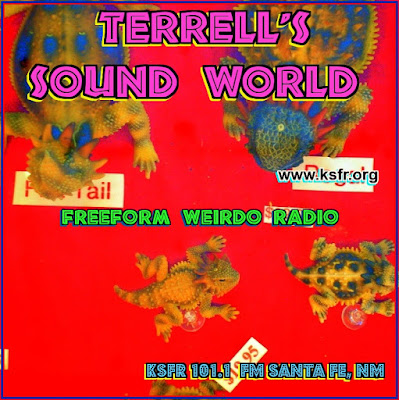January 12, 2007
Late last year, two albums were released featuring never-released or long-out-of print recordings from late, great, American wild man originals — Hasil Adkins and Blaze Foley.

Besides the fact that they both played guitar and they’re both dead — Foley was shot to death in 1989, while Adkins died in 2005 just shy of his 68th birthday — one might conclude that Blaze and Haze don’t have much in common. But both men’s music generally was overlooked by the mainstream. And both artists inspired worshipful cults. In my view, the worship is well-deserved, and these new albums should be seen as sacraments.
*Best of the Haze by Hasil Adkins. The crashing strum of an out-of-tune guitar with a menacing backwoods voice declaring, “Well I’m gonna tell you what happened” is the foreboding start of this record. It’s as if you’ve found yourself in a nightmare in which you’re trapped in a hillbilly’s still house on the wrong side of the cosmic tracks — where the guy talking has one hand on the neck of a battered guitar and the other hand on a shotgun.
How can you describe Hasil Adkins? I don’t think I can top All Music Guide, which called him a “frantic one-man band who bashed out ultra-crude rock & roll tunes about sex, chicken, and decapitation into a wheezing reel-to-reel tape machine in a West Virginia shack.”
Probably the best known of those groups who went on the Adkins diet is The Cramps, whose trademark “psychobilly” sound sprang from the Haze.
He started out in the 1950s, recording his bizarro-world one-man rockabilly for tiny regional labels. It was those early 45s that inspired The Cramps and others and eventually led to Adkins recording long-players in the ’80s and ’90s on the Norton label (plus an album on Fat Possum Records and a live recording from the Chicago-based Bughouse label).
Unfortunately, despite the title of this album, you won’t find those scratchy-but-sublime old recordings here. What Best of The Haze offers is a bunch of tracks from early-’90s sessions for a never-released album on the now-defunct IRS label (once the home of R.E.M., Concrete Blonde, and Wall of Voodoo, among others).
He’s older in these recordings but hardly mellower. There are some re-recordings of classic Haze “hits” (including the opening cut “She Said” and “This Ain’t No Rock ’n’ Roll Show”), a couple of cover songs (Hank’s “I’m So Lonesome I Could Cry” and Elvis’ “Teddy Bear”), a Christmas tune (“Santa Claus Boogie”), and even a gospel tune (“Me & Jesus”).
But the best is “Wild Man” — another re-recorded old song that shows Adkins as the ultimate dirty old man. The song basically consists of Haze frantically strumming his guitar, apparently tuned to the key of H, and singing — sometimes almost screaming — “verses” that repeat the phrase “you call me a wild man” and stopping every so often to speak lines like: “Now you wouldn’t take your clothes off would ya? [pause] Well, if you did, it would be all right!”
*Cold, Cold World by Blaze Foley and The Beaver Valley Boys. While it’s not hard to see why an acquired taste like Hasil Adkins never made a splash in the mainstream, Blaze Foley should have been a star.

Only thing is, Blaze lived as crazy as Haze sang. He was essentially homeless, sleeping under pool tables at bars. He patched up old shoes with duct tape.
But this hard-drinking, even harder-living Texan (born Michael David Fuller) wrote what can only be called some mighty songs. His best known surely is “If I Could Only Fly,” the stunning title track of Merle Haggard’s best album of this century. Hag, who also recorded that song with Willie Nelson about 20 years ago, reportedly has contemplated releasing a whole album of Blaze songs.
Haggard’s not alone. John Prine sang Foley’s “Clay Pigeons” on his last album. Both Lucinda Williams and Townes Van Zandt wrote songs about Foley (“Drunken Angel” and “Blaze’s Blues,” respectively). And there have been several little-noticed Blaze tribute albums, featuring performances mainly by the singer’s Austin pals, released in recent years.
Cold, Cold World is graced by Gurf Morlix, a fine artist in his own right who plays guitar and bass and sings backup here. The songs were recorded in 1979 and 1980 — at a time when some thought Foley might reach some level of mainstream success.
The album has some pretty country songs like the title song and the mournful “Picture Cards” (which has similarities to “If I Could Only Fly”), some breezy, bluesy stuff like “No Goodwill Stores in Waikiki” and “Slow Boat to China,” and even some topical numbers like “Election Day” (later recorded by Lyle Lovett) and “Officer Norris” (a protest against a cop).
Foley’s wry humor is all over the album, especially on songs like “Christian Lady Talkin’ on a Bus,” “Big Cheeseburgers and Good French Fries,” and “New Wave Blues” which starts out, “There goes that tongue again, back in my ear again.”
The man should have been a star.




